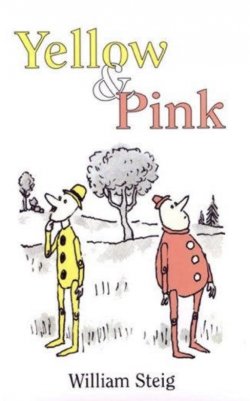Gareth B. Matthews

Review of Yellow and Pink by William Steig (New York: Farrar, Straus & Giroux, 1984). Originally published in Thinking: The Journal of Philosophy for Children 5(4): 1.
Two wooden figures, one painted pink, the other yellow, lie on newspapers in the sun, perhaps to dry. They look like marionettes. The pink one is short and fat, whereas the yellow one is straight and thin.
Each starts to wonder what he is doing there on the newspaper in the sun. When Yellow notices Pink beside him he asks, “Do I know you?”
“I don’t think so,” Pink replies cautiously.
”Do you happen to know what we’re doing here?” Yellow asks. Pink doesn’t know.
” Who are we? ” asks Yellow. Pink doesn’t know that either. “Someone must have made us,” Pink surmises.
Yellow produces all sorts of difficulties with Pink’s hypothesis and himself concludes, “We’re an accident, somehow or other we just happened.”
Pink starts laughing. “You mean these arms I can move this way and that,” he asks, ”this head I can turn in any direction, this, breathing nose, these walking feet, all of this just happened, by some kind of fluke? That’s preposterous!”
Yellow is unmoved. He admonishes his companion to stop and reflect. “With enough time,” he says, “a thou sand, a million, maybe two and a half million years, lots of unusual things could happen. Why not us?”
Patiently Pink takes up one feature of their construction after another. In each case he challenges Yellow to suggest how that feature could have been the result of an accident. For each feature Pink mentions Yellow tries to say how that feature could, indeed, have been the result of an accident.
Finally, a mustachioed man shambles up, examines Pink and Yellow, and announces, with satisfaction, “Nice and dry.” As the man takes Pink and Yellow away, tucked under his arm, Yellow whispers in Pink’s ear, “Who is this guy?” Pink doesn’t know.
In the Fifth Century B.C. Empedocles speculated that animals and human beings could have been the accidental concatenations of bits and matter, concatenations that just happened to function well as units. The ideas of Empedocles, and, after him, those of Democritus, Epicurus and Lucretius, are quite Darwinian, except that the ancients had no genetic theory to explain how a chance concatenation of bits and parts that happened to function well as a whole could reproduce itself, so that the type would survive.
Plato, with his picture of the Master Craftsman creating the world and all its inhabitants according to eternal blue prints, was Pink to Empedocles’s Yellow. Plato’s pupil, Aristotle, was at least Pinkish, and also a clear opponent of Yellow.
The debate continues, right down to the present day. David Hume and Charles Darwin refined the terms of the debate, but they did not settle it.
In Steig’s story the mustachioed man at the end vindicates Pink, even though, not recognizing his maker, Pink doesn’t realize he has been vindicated. But is Steig’s story also the story of our world? And how can we find out?
Yellow and Pink is a gem. Not a question, comment or descriptive detail in it is wasted. And the illustrations, also by Steig, do much more than illustrate; they embody the story they help tell.
Someone will ask who the story’s audience is meant to be. (Someone always does.) No doubt that question is almost as tricky and intriguing as the story’s own question, ‘Who are we?’ Perhaps Mr. Steig will say he wrote the story for himself. But I shall be dogmatic and insist that his story is as much for the child philosopher in every reflective adult as it is for the aspiring scientist and incipient theologian in every curious child.
